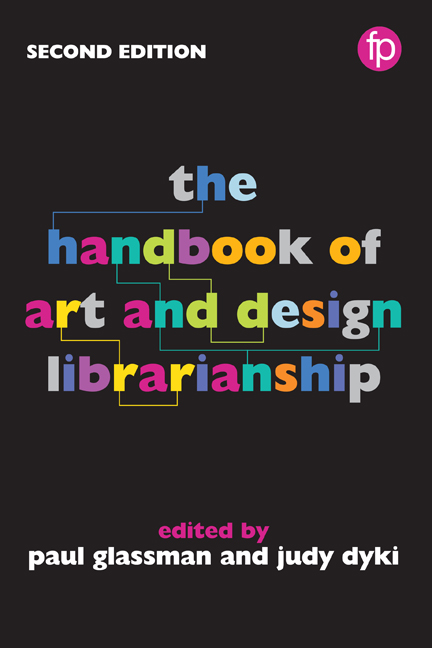Book contents
- Frontmatter
- Contents
- List of figures and tables
- Notes on contributors
- Foreword
- Preface
- Part I Roles and responsibilities
- Part II Materials and collection management
- 6 Visual resources: from analogue to digital and beyond
- 7 Developing digital collections
- 8 Inspirational encounters: the management and use of archives and special collections in the art and design library
- 9 What is special about special collections?
- 10 Artists’ books in the art and design library
- 11 Art documentation: exhibition catalogues and beyond
- 12 Tactile libraries: material collections in art, architecture and design
- 13 Seeing the bigger picture: archival description of visual information
- Part III Teaching and learning
- Part IV Knowledge creation
- Part V The physical environment
- Part VI Promotion and sustainability
- Appendix Library profiles
- Index
10 - Artists’ books in the art and design library
from Part II - Materials and collection management
Published online by Cambridge University Press: 08 June 2018
- Frontmatter
- Contents
- List of figures and tables
- Notes on contributors
- Foreword
- Preface
- Part I Roles and responsibilities
- Part II Materials and collection management
- 6 Visual resources: from analogue to digital and beyond
- 7 Developing digital collections
- 8 Inspirational encounters: the management and use of archives and special collections in the art and design library
- 9 What is special about special collections?
- 10 Artists’ books in the art and design library
- 11 Art documentation: exhibition catalogues and beyond
- 12 Tactile libraries: material collections in art, architecture and design
- 13 Seeing the bigger picture: archival description of visual information
- Part III Teaching and learning
- Part IV Knowledge creation
- Part V The physical environment
- Part VI Promotion and sustainability
- Appendix Library profiles
- Index
Summary
What is an artist's book?
Artists’ books were an important part of the experimentation in the visual arts that started in the late 1950s and continued into the 1960s. This was a time of anti-establishment thinking, experimental ideas and actions, seeking to get art off the wall and into the hands of the viewer and reader. Examples at that time included happenings, performance art, mail art, pop art, Fluxus and conceptual art – where concept was more important than its realization, and when there was a shift from art as an object to art as an idea. Many artists held the conviction that art must be withdrawn from its special status as rarefied experience and shared among the public at large. By the early 1970s, curators began attempting to define and describe these publications. In 1973 Diane Vanderlip curated an exhibition at the Moore College of Art in Philadelphia entitled Artists’ Books, and the phrase stuck. Following this exhibition, bookshops were founded to sell and distribute these unusual publications: Art Metropole (Toronto; www.artmetropole.com/about) in 1974, Other Books & So (Amsterdam) in 1975 and Printed Matter (New York City; www.printedmatter.org/what-we-do) in 1976, among many others.
Since Vanderlip's exhibition, many people have attempted to refine the definition of what constitutes an artist's book. The simplest definition uses the Duchampian prompt: ‘It's an artist book if the artist says it is.’ In her essay ‘The Artist's Book Goes Public’ Lucy Lippard described an artist's book as ‘neither an art book (collected reproductions of separate art works) nor a book on art (critical exegeses and/or artists’ writings), the artist's book is a work of art on its own, conceived specifically for the book form and often published by the artist him/herself ‘ (1985, 45). Lippard was one of the founders of the bookshop Printed Matter, along with Sol LeWitt and others, and she would have seen the Vanderlip exhibition catalogue. Paul Bianchini, the late pop art dealer, is quoted by Anne Moeglin-Delcroix in an epigraph: ‘An artist's book is a work solely created by the artist's decisions. It is produced by the best methods to achieve quality in unlimited quantities.
- Type
- Chapter
- Information
- The Handbook of Art and Design Librarianship , pp. 99 - 108Publisher: FacetPrint publication year: 2017
- 1
- Cited by



